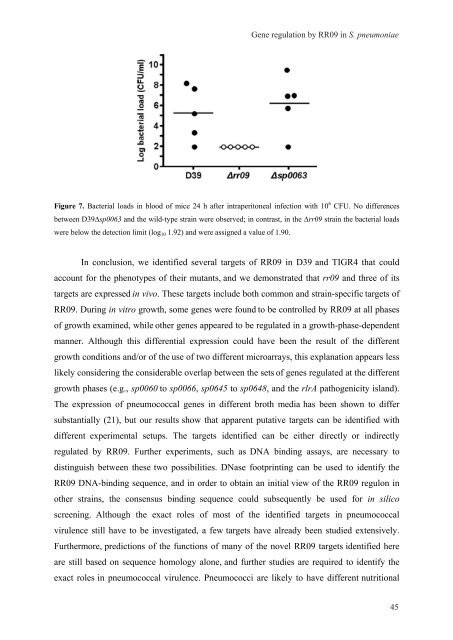Gene regulation in Streptococcus pneumoniae - RePub - Erasmus ...
Gene regulation in Streptococcus pneumoniae - RePub - Erasmus ...
Gene regulation in Streptococcus pneumoniae - RePub - Erasmus ...
You also want an ePaper? Increase the reach of your titles
YUMPU automatically turns print PDFs into web optimized ePapers that Google loves.
Figure 7. Bacterial loads <strong>in</strong> blood of mice 24 h after <strong>in</strong>traperitoneal <strong>in</strong>fection with 10 6 CFU. No differences<br />
between D39∆sp0063 and the wild-type stra<strong>in</strong> were observed; <strong>in</strong> contrast, <strong>in</strong> the ∆rr09 stra<strong>in</strong> the bacterial loads<br />
were below the detection limit (log10 1.92) and were assigned a value of 1.90.<br />
<strong>Gene</strong> <strong>regulation</strong> by RR09 <strong>in</strong> S. <strong>pneumoniae</strong><br />
In conclusion, we identified several targets of RR09 <strong>in</strong> D39 and TIGR4 that could<br />
account for the phenotypes of their mutants, and we demonstrated that rr09 and three of its<br />
targets are expressed <strong>in</strong> vivo. These targets <strong>in</strong>clude both common and stra<strong>in</strong>-specific targets of<br />
RR09. Dur<strong>in</strong>g <strong>in</strong> vitro growth, some genes were found to be controlled by RR09 at all phases<br />
of growth exam<strong>in</strong>ed, while other genes appeared to be regulated <strong>in</strong> a growth-phase-dependent<br />
manner. Although this differential expression could have been the result of the different<br />
growth conditions and/or of the use of two different microarrays, this explanation appears less<br />
likely consider<strong>in</strong>g the considerable overlap between the sets of genes regulated at the different<br />
growth phases (e.g., sp0060 to sp0066, sp0645 to sp0648, and the rlrA pathogenicity island).<br />
The expression of pneumococcal genes <strong>in</strong> different broth media has been shown to differ<br />
substantially (21), but our results show that apparent putative targets can be identified with<br />
different experimental setups. The targets identified can be either directly or <strong>in</strong>directly<br />
regulated by RR09. Further experiments, such as DNA b<strong>in</strong>d<strong>in</strong>g assays, are necessary to<br />
dist<strong>in</strong>guish between these two possibilities. DNase footpr<strong>in</strong>t<strong>in</strong>g can be used to identify the<br />
RR09 DNA-b<strong>in</strong>d<strong>in</strong>g sequence, and <strong>in</strong> order to obta<strong>in</strong> an <strong>in</strong>itial view of the RR09 regulon <strong>in</strong><br />
other stra<strong>in</strong>s, the consensus b<strong>in</strong>d<strong>in</strong>g sequence could subsequently be used for <strong>in</strong> silico<br />
screen<strong>in</strong>g. Although the exact roles of most of the identified targets <strong>in</strong> pneumococcal<br />
virulence still have to be <strong>in</strong>vestigated, a few targets have already been studied extensively.<br />
Furthermore, predictions of the functions of many of the novel RR09 targets identified here<br />
are still based on sequence homology alone, and further studies are required to identify the<br />
exact roles <strong>in</strong> pneumococcal virulence. Pneumococci are likely to have different nutritional<br />
45<br />
45

















